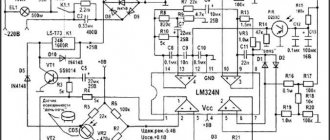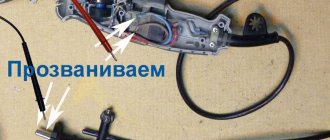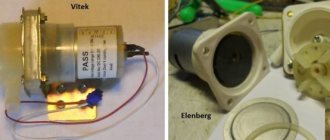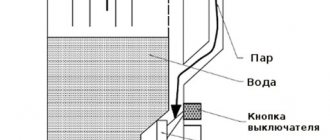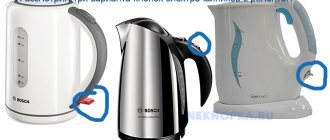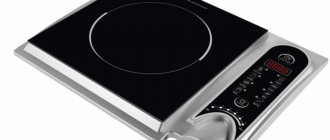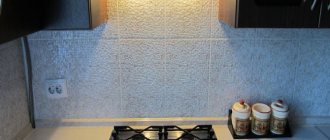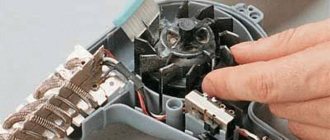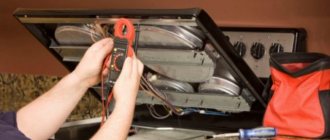Automatic coffee machines are very convenient to use: the drink is prepared in a matter of minutes, and you only need to put in a minimum of effort. Therefore, it becomes especially disappointing when a useful assistant in the kitchen breaks down. Repairing a coffee machine in service centers is a long and expensive undertaking. But sometimes the problem can be solved on your own, without resorting to the help of specialists. Let's look at the most common coffee machine malfunctions and how to fix them at home.
Water is leaking from under the horn
If you find that the coffee machine is leaking at the junction of the horn and the body, this is not a very serious malfunction that can be easily repaired with your own hands. Most likely, water is flowing due to the fact that the sealing ring at the junction of the so-called “spout” and the body of the coffee machine is clogged. Clogging can occur due to anything: fat deposits, wet pulp, coffee, foreign objects, etc. In this case, to repair you only need to wash the contaminated area and reassemble the horn.
If the coffee machine is leaking because the seal is damaged (cracked or torn), you need to replace it with a new one. Here you should draw your attention to the fact that it is necessary to replace the o-ring with one with exactly the same characteristics. If you simply find a similar shaped seal in your home workshop (for example, from a car part), you don’t need to install it, because the rubber from which such a product can be made may not be sufficiently resistant to temperatures or not so elastic. The same requirement applies to other consumables!
How to fix a leak yourself
We also draw your attention to the fact that when repairing a coffee machine like this yourself, you need to check the filter of the horn before installing a new seal. Perhaps the filter is clogged with coffee deposits and the breakdown occurred due to the fact that water under pressure was looking for a weak point of breakthrough. If the filter is not cleaned on time, more serious problems may occur.
By analogy, you can repair or replace any other oil seal that is leaking. Did you see water running out of the coffee machine? Don't be afraid to repair the problem area yourself. The main thing is to do this in time, before the water reaches the wiring and electronic unit. Timely repairs can protect you from electric shock and your equipment from complete failure. It should also be noted that the opposite situation - when the coffee machine does not pump water, can occur due to a malfunction of the piston located above the brewer. You can also try to repair it yourself after a visual inspection.
This is interesting: Inlet hose for a washing machine: types, replacement, selection criteria
The coffee machine is leaking or leaking
Water is leaking from under the coffee horn, accumulating under the coffee machine, the O-rings should be checked. Often, ground coffee, grease and dirt get underneath them. The seal is broken and steam escapes. For DeLonghi models, the instructions draw the attention of buyers to careful handling of coffee machines. Their water accumulates in the pan and under the machine itself.
Open the housing, remove the coffee brewing unit and check the O-ring. Remove it, wash it, clean the entire unit and reinstall it. If cracks form on the ring, you need to buy a new one. To do this, you should take your passport to a specialized store. Rings from equipment from other companies will not fit. They will be rougher or softer, of different sizes.
The horn filter should be washed. If it is clogged, steam coming under high pressure finds its way out in a weak spot. By analogy, the brewing unit in a coffee machine is checked and all tubes are cleaned.
Leaks must be repaired in a timely manner. There is a lot of electrical equipment inside the car. If water gets on it, a short circuit to the housing and electric shock may occur. At best, the motor or board will burn out.
The pressure in the horn decreased and noise appeared
If you see that the water from the coffee machine is flowing poorly, then the mesh or the filter itself is clogged. You can clean the coffee machine yourself. During cleaning, you can use special detergents. Special products for cleaning a coffee machine or coffee maker can be found in any store. You can remove debris with a toothpick. When repairing your coffee machine yourself, be careful. Be careful not to scratch the internal components.
If your coffee machine is noisy or does not pour coffee well, then the reasons for the breakdown of coffee machines are obvious. You should simply clean the clogged filter. If you see coffee dust when disassembling the coffee machine, then you should adjust the grind size.
Doesn't pour coffee
If the coffee flows in a thin stream or does not drip at all, you should start by rinsing and cleaning all pipes and components from salts, fats and dirt. The machine hisses, steam rushes out and does not enter the cooking unit, it is necessary to carry out decalcification - descaling. To do this, you should use a special composition. As a last resort, a solution of citric acid, and rinse well after it. You can't rinse with vinegar.
All components should be cleaned of coffee dust, oils and dirt. If after this the problem does not disappear, you should contact the service center.
disassemble How to disassemble a coffee machine?
To carry out repairs for the coffee machine, it first needs to be disassembled. And how to do it correctly is described step by step. Necessary.
- Below you will find the back wall of the device, and more precisely the installation screws. Unscrew it with a screwdriver, pliers, or whatever is at hand and is ideal for such work, set aside. It is worth noting that there may be several options for screws. They can be hidden, or cross-shaped with a convex head;
- The screws have been removed, which, logically, the cover should be easy to remove. If, however, it cannot be removed, then there are hidden locks in the case. Most often these are ordinary plastic latches and they are located at the bottom of the back cover. From the outside, such a lock can be easily opened with a knife or a small screwdriver;
- Finally got access to the “insides” of the machine, it’s time to start repairs.
And so let's go in order. There is a blockage in the water supply pipe. For such DeLongy coffee machines: like, Bork, Ariete, Ariete and cleaning, others are done using a long and thin rubber hose. It needs to be run along the same flow path to break through the blockage. However, it will be much more effective to use special brushes with a flexible stem.
Advice:
It is a little more difficult to clean the filter with your own hands. With frequent use of the coffee machine, scale accumulates on the filter, salt residues, coffee plugs, etc. You need to be careful when cleaning, but the main thing is to do it carefully according to the instructions, otherwise you may damage the integrity of the part. During the process, it is allowed to use a soft swab sprinkled after. Clean the filter thoroughly with cleaning alcohol.
Coffee machine companies Mulinex, Krups, Roventa, Saeko still have one problem - water leaks. The valve that regulates the water supply is located in the filter practically. If the coffee does not stop pouring, a worn valve is most likely to blame, which leads to this phenomenon.
The valve cannot be repaired; in this case, the only option is to replace it with another new part. To understand whether the valve is broken, simply pour the coffee out of the machine, disassemble it, wash it and inspect any possible damage.
How to disassemble
Part of the answer to the question of how to disassemble a coffee machine looks like this: you should definitely stock up on a screwdriver with a long thin slot, various bit attachments, and, if available, capes for unscrewing hexagons; thin pliers will also come in handy. In general, the process looks like this:
- The back wall is freed from the mounting screws. They can be very different - with a cross, hex key, asterisk, recessed, with a semicircular or flat head.
- If you cannot release the back panel, you should inspect the structure for the presence of latches. They are bent with a long slotted screwdriver.
- After the walls are freed, they can be disassembled further; the process depends on the specific model of the product.
Some coffee machines give access to most components after removing the back panel. Others will have to be examined more thoroughly. For example, for Saeko machines the complete process looks like this:
- First, the front panel is opened and the waste containers and coffee dispensing unit are pulled out.
- The mug stand is dismantled and moves forward along with the tray.
- The water container is removed from the rear; after removal, access to the bean compartment lid opens.
- To dismantle the coffee storage compartment, you need to unscrew all the fastening screws and carefully pull it out.
- Another mounting screw needs to be removed under the container.
- Dismantling continues from the front panel; there are a couple more fasteners there, accessible from below.
- Behind the bean compartment there is a final, deeply recessed mounting screw.
- When removing the top panel of the coffee machine, you need to disconnect the water supply hose.
- Dismantling is completed by removing the front door.
Main components of the Saeko coffee machine
After such disassembly, you can get to all components of the device. This will make it possible to inspect, clean and lubricate the mill mechanism, and check for voltage at key points in the electrical circuit of the Saeco coffee machine.
There was noise from inside, the pressure from the horn decreased
If you notice that the water from the coffee machine is flowing poorly and at the same time there is an extraneous whistle or noise, it means that the mesh or the filter itself in the horn is most likely clogged. It won’t be difficult to wash it, not to mention that such repairs won’t take much time. Special products are sold for cleaning coffee machines or coffee makers from grease. You can also carefully remove debris with a toothpick. The main thing is that when repairing a coffee machine on your own, do not scratch the internal containers, as even small scratches will retain the ground coffee, which contributes to the rapid clogging of the equipment.
If the coffee machine is noisy and does not pour coffee well, it may even be because the filter is clogged due to the coffee beans being ground too strongly. Start the repair by opening the container with coffee beans and checking the grind size. If you see coffee dust, adjust the grind size manually (many coffee machines have this function). Well, the last reason for extraneous noise is wear of the internal pump mechanism, as a result of which the coffee machine makes noise, hums and does not pour water well. In this case, the weak pressure can only be repaired by replacing the pump.
What to do if the coffee flows weakly from the cone
Noise inside the device during operation
If there is extraneous noise inside the coffee maker during its operation, the quality of the drink deteriorates, the cup is filled to half, or other problems appear - the system should be flushed. It is better to do this by using a special cleaner for coffee machines.
It is necessary to remove all the blocks, wash the filters, coffee grinder, and steam supply pipes. You should check the bunker for disposal of cake, pay attention to the strength of fixation of various components, the presence of foreign objects. Specks can be removed with a toothpick. Metal tools must not be used. It will scratch the smooth surface and clog with ground coffee will occur more often.
Why does a coffee machine break down?
Proper operation and care of the coffee machine ensures long-term service and stable operation. Unfortunately, in an office environment, coffee machines often work continuously, almost to the point of wear and tear, and it is not always possible to take good care of and thoroughly clean all the elements of its design: there is simply not enough time. However, regular maintenance, cleaning and general checks on the functionality of the coffee machine will significantly reduce the risk of breakdown. Here are the points you should pay attention to in advance.
- Low quality water is used to make coffee. If you use ordinary tap water, unfiltered, saturated with chlorine and other harmful impurities, sooner or later this will lead to the formation of scale and limescale on the internal parts of the coffee machine.
- Power outages. Periodic power failures and frequent switching on/off of the device also contribute to breakdowns.
- Wear of parts during long-term use. If the coffee machine has been serving you faithfully for more than a year, natural wear and tear of the structure may occur. Here it is better to consult a specialist: perhaps some parts still need to be replaced.
- Careless operation of the device, lack of regular cleaning. Cleaning your coffee machine is one of the most important maintenance components. Often, special cleaning products, descaling tablets, etc. are included with the device, but in certain cases, thorough manual cleaning is also necessary.
- Ingress of foreign objects into the structure, clogged filters.
These are just general reasons why your favorite coffee machine may suddenly break down. Next, we will highlight typical types of breakdowns that can occur with coffee appliances of various types and functionality.
This is interesting: Do-it-yourself iron repair: troubleshooting
The coffee machine is very noisy
If, while making coffee, you notice that the coffee machine makes strange noises: crackling, hissing or whistling, then most likely the filter or mesh in the coffee horn is clogged. What to do in this case? Carefully disassemble the structure and clean clogged areas. The most convenient way to do this is with the help of special cleaning products for coffee machines and coffee makers.
Perhaps you are using coffee that is too coarsely ground, and the pores of the filter simply cannot handle the particles, and the water pressure, in turn, causes cracks to form. Open the container where you usually put coffee beans and check how coarse the grind is. To facilitate this task, many coffee machines have a function for adjusting the grind size.
Another version of why the noise is too loud is the natural wear and tear of the built-in pump. In this case, you will simply have to replace the part.
Why doesn't the coffee machine turn on?
If your coffee maker won't turn on, it could be due to many problems. Among them, the most common ones are most often identified.
- Electrical cable is bent or broken. To eliminate the defect, it must be replaced.
- When there are sudden power surges in the network, the fuse trips and the coffee machine stops turning on. In order for it to work again, this part must be replaced. It is recommended to use a stabilizer that will prevent damage to household appliances.
- If the coffee maker is running continuously, it may overheat. In this case, the thermal protection will work and turn off the device. In this situation, you just need to let the coffee machine cool down.
- With prolonged use, scale forms in the coffee maker and coffee deposits appear. All this can lead to open contacts. To start brewing coffee again, you need to thoroughly clean the device and restore the contacts.
- Control module failure. This defect is the most serious, and to correct it you will have to seek the help of professionals.
However, the problem is not necessarily with the coffee maker. First you need to check the following.
- Make sure there is electricity in the apartment. It is quite possible that the plugs in the electrical panel were knocked out.
- The machine may turn off due to clogged filters. They need to be cleaned or replaced. After this, the device will operate normally.
The coffee machine does not brew coffee: what else should you pay attention to?
A technically complex coffee machine does not break down just like that. Usually, if a device does not perform its duties, this is due to several problems at once:
- There is no response to the buttons, so the device will not brew coffee. If the coffee maker is equipped with a self-diagnosis system, the error code will indicate the exact cause of the malfunction. It happens that water or coffee gets on the buttons, so they stick and do not work. In this case, you must contact the service center for comprehensive cleaning of the device.
- The lack of power, even though the cable is intact and the socket is working, is a reason to disassemble the coffee machine and test all sections of the circuit using a multimeter. It is better to entrust this procedure to a professional.
- The household appliance “does not see coffee” and does not grind grains. This happens if the control unit or coffee dispenser with funnel fails. Or maybe dust from ground coffee has gotten into the motor, in which case immediate replacement will be required. It is better not to do such an important task yourself, but to call a professional.
- The appearance of extraneous noise together with a complete failure of the coffee machine indicates the formation of an air lock. To solve the problem, you will need specialized coffee maker cleaning products and the help of a specialist.
Other side symptoms are also possible if the device does not work at all. However, it is not possible to determine the exact cause of the malfunction. The Polite Service specialists will handle the task faster and more efficiently.
Error on display
If the coffee machine gives an error, then you should study the operating instructions. Manufacturers of coffee machines can indicate the cause of the breakdown in the instructions.
Most often, the cause of a breakdown can be a broken sensor. In this case, the coffee machine can be repaired by flushing the system. Usually, a thorough inspection of the device and study of the operating instructions helps to cope with malfunctions. If you have lost the instructions, then you can find possible errors on the Internet.
The main problems of coffee machines and coffee makers
- The water supply is interrupted. There is a blockage in the mechanism pipeline;
- The coffee has acquired an unusual smell or taste. In this case, you don’t always need to fix something yourself. Perhaps you just need to change the coffee tablets, and there is a very wide choice of them: Dolce Gusto - Dolce Gusto, Nestle, Jacobs, etc. Alternatively, the coffee machine filter may become clogged. Another factor affecting the taste and smell of coffee can be cheap plastic. During operation, some parts of the machine heat up to 130 degrees, which can cause the plastic to melt;
- Cold coffee. Most likely, your heating element has stopped working;
- The carob coffee maker does not work. This can be influenced by many factors: the motor is broken, the pump is not working, the power cable is broken;
- The dosage of water has been exceeded (most often found in capsule coffee machines). Most likely, the breakdown lies in the engine or in the timer operating circuit.
- The cooking time setting circuit does not work or the dosage per cup is incorrectly adjusted. Of course, you need to focus on the model of the device and its brand, but a common reason is the incorrect operation of the engine control circuit or one of its compartments.
If you are not sure that you can repair a coffee machine, then it is better to take it to specialists. If the device is under warranty, then there is no point in disassembling it at all; it will instantly lose the warranty.
Advice:
Frequent breakdowns, repair of Delonghi coffee machine
We will analyze some breakdowns that occur as a result of incorrect operation. By incorrect exploitation we understand the following. No constant cleaning:
- waste coffee container
- drip trays
- rinsing water barrel
- coffee spouts
- funnels for adding ground coffee
- inside the coffee machine behind the door
- and eventually a brewing unit that is simply removed
All parts outlined above should only be cleaned with the coffee machine switched off!
The coffee machine has finished preparing coffee
The first and sometimes most common breakdown of these coffee machines. Due to difficult movement of the brewing unit due to untimely cleaning. The coffee machine refuses to pour coffee. And in general, a dirty hob causes a huge number of problems. Wear of the gearbox, drive, motor, gearbox bearing. These are all very expensive repairs. Only the most experienced technician will be able to figure out and remove these faults in the coffee machine.
Scattered pulp inside the coffee machine
In most cases, scattered cake occurs due to very small grinding. The small grind size prevents the pressed coffee from forming into a hard form. As a result, a slurry appears that simply diverges in different directions, preventing the paddle from making a proper discharge. But this is not the only reason for this breakdown. A broken brew unit or receiving part is not working properly.
The coffee machine hisses inside during operation
Call us without delay. When the inside of the Delonghi coffee machine begins to hiss, this is the first sign of a water leak. The longer you wait to repair such a car, the more expensive and longer the repair will take. A water leak from a hydraulic system has a huge number of predictable consequences. For example, the heating element inside the thermoblock burns out. Perhaps this is one of the most expensive repairs for Delonghi coffee machines of any model.
A cracking sound appeared when grinding coffee beans
Hard objects getting into the coffee grinder such as stones, over-roasted coffee beans, nut shells and anything else. It can dull the millstones, break the coffee grinder gearbox, and destroy the motor. You need to disassemble the coffee machine, remove the entire coffee grinder and carry out a thorough cleaning. Such a procedure with an on-site specialist will cost you 2,500 rubles.
The water in the coffee machine has stopped flowing
We have already written about the destructive inaction of the user. This is one of the circumstances of a clogged coffee machine hydraulic system. Hard water clogs the water supply system quite intensively. Especially the heating element, which has a very narrow passage. A wealth of scale forms plugs that make life difficult for the entire coffee machine. Here is the consequence of untimely decalcification for you.
In conclusion, I would like to say that the repair of Delonghi coffee machines by UseHead is even very advisable. For example, buying a new coffee machine will cost you 5 times more than repairing yours, and we don’t think this is the cheapest repair. Customers often ask the question: “how long will a coffee machine last after repair?” The answer is simple: for a long time, subject to proper use!
Is it worth repairing Delonghi coffee machines?
Of course, we absolutely do not want to overshadow your happiness with imaginary problems. This is just how life is and everyone may find it necessary to repair a Delonghi coffee machine someday and find, for example, a means to clean the coffee machine. Only some will require repairs after a couple of months of operation, while others will require repairs after a couple of years. We simply wish that this does not come as a complete surprise to you and does not take you by surprise.
Buttons don't work
If the coffee machine does not respond to pressing buttons or other possible commands, there may be several reasons for the malfunction. First, check that there is water and coffee in the appropriate containers, because... Most modern coffee machines will not turn on in the “idle” position. Secondly, look closely at the display, which may immediately indicate a certain error. After a visual inspection, you can move on to more serious repairs - remove the front panel and use a multimeter to test all the buttons for power. We have already told you how to use a multimeter.
Sometimes the buttons do not work because coffee was poured on them before and now they are stuck. You can remove sticky dirt with a cotton swab dipped in alcohol. We've done everything, but you still can't set up the buttons on the coffee machine? It is better to contact specialists, because... The problem may lie in a malfunction of the electronic control unit, and in this case, repairing a coffee machine is much more difficult. For those who are “friends” with the tester and know how to check the integrity of the circuit, we advise you to sequentially check all the elements of the circuit. Perhaps the coffee machine is not working because the fuse has blown or some resistor has failed. Replacing a broken component on a board is not difficult if you know how to do it.
A selection of coffee machine faults.
Hello everyone, I decided to post assorted photos of coffee machine malfunctions. There will be a photo, then a few words about what you just saw.
Philips Saeco multivalve reducer. I don’t remember which one exactly. The valve began to leak, the gearbox with the motor is located under the valve, it is flooded and rotted. In general, a “marketing ploy” by engineers)
Krups. That says it all. The silicone coffee outlet tube moves with the piston, and over time the plastic tube into which the silicone tube fits broke off. As a result, coffee comes out of all the cracks, but not into the cup)) If Krups has normal machines, I haven’t seen them. I have never seen anything more stupid than these machines in a technical sense. Everything was done “to choke”!
Phillips saeko. Emergency pressure valve. Again a “marketing ploy” by the engineers. The plastic is thin, the spring is strong, from the vibration pump, and the discharge tube is bent into a bullish one. The thinnest part couldn't stand it.
I turned out the remains only with the help of some mother.
Since through this tube the water is discharged directly into the pan and does not come into contact with drinking water or coffee, it is possible to create a collective farm. The metal tube is the elbow of the telescopic antenna from the radio receiver)
Ready. It sealed perfectly.
Philips saeko x-small. Water did not flow into the brewing unit. You just need to do decalcification on time. The whole car was filled with such pieces of calcium. The photo shows the coffee/steam valve.
Old lady Yura stood in some basement for probably 10 years. Life had already begun in her) Enterprising people decided to restore her.
The brewing unit, like that of cereals, is not user serviceable, no one washed it.. I had to wash it and lubricate it. I didn’t dare drink coffee from it)
Mileage. Odometer type)
Some Bosch, I don’t remember. The PCB under the triac of the coffee grinder burned out and shorted. When plugged into the socket, the coffee grinder immediately worked) Wire cutters and hanging installation according to GOST “snot” fixed everything)
Thank you all for your attention, ask questions, I will try to answer.
What model of coffee machine do you think
the most reliable one you can buy for your home?
I join the question
Delonghi ECAM 22.110.SB Magnifica S is relatively inexpensive and, in my opinion, worthy of any kitchen.
A coffee machine technician is needed in Rostov-on-Don. The poor guy is standing in the office, working on his last legs.
Friends have this godless Philips Saeco, it worked for a year and they were already repairing the brewing unit. I have a Delonghi 3200 for 5 years, the flight is normal, the main thing is not to be lazy and, in addition to draining the water and throwing out waste, wash the brewing unit, and also do decalcification during the process.
Saeko has been working for us for almost 7 years, without any lags. Need to rinse more often
I will show this thread to clients so that they know that it’s the car that needs to be cleaned, and not the “manufacturer’s wank”)
Good afternoon. Can you tell me if the Philips Saeko coffee machine started to wake up/appear a lot of coffee under the brewing unit, what could it be?
Delonghi ECAM 3000 V is also normal, they are approximately in the same price range.
Delonghi ecam any of this series. Wash, maintain, lubricate more often, read the instructions, do not turn on without water and coffee and this will last you a long time.
Please tell me, delonghi esam 2600, started scattering work inside the case. In other words, the pressed and spent coffee tablet crumbles when the brewing unit tries to dump it into the waste container. First, according to the instructions, I left the brewing unit in water for 20-30 minutes, which was enough for literally a couple of days. We drink a day
2 cups of coffee. About a month ago I disassembled the entire brewing unit, washed it and lubricated it with silicone grease (which came with the Phillips coffee machine), as a result, now it’s scattering coffee again.
What could it be? Crooked hands, crappy lubrication, or am I missing something?
1 leaking thermoblock (for service)
2 replace both rings on the piston
3 clean the valve and mesh in the piston
4 reduce grinding
5 information search engines on the Internet
How do I understand all these problems with coffee machines “press and done”?
Filter dirty
Replacing the water filter in a coffee machine is a responsible job. If you replace the filter incorrectly, then an air lock may form in your device. Here are instructions to help you properly replace the filter:
- You need to turn the filter over with the inlet and outlet openings facing up.
- Fill it with water.
- Pour water into the coffee machine reservoir.
- Install the device.
- If the water does not flow through the spout, then you need to increase the pressure.
A light comes on or an error appears on the display
If the coffee machine gives an error (as in the photo below) or the indication on the front panel lights up (the light is blinking), first look at the operating instructions. Manufacturers of coffee machines must indicate in the booklet all possible errors, the reasons for their occurrence and how to repair them yourself.
Most often the problem occurs due to a malfunction of a sensor. In this case, you can try to repair the coffee machine by completely cleaning and flushing the system. Did not help? Check that all containers are fully inserted and that the float in the water tank works. Usually, a thorough visual inspection and familiarization with the operating instructions helps to quickly repair the breakdown. With coffee machine errors, everything is much simpler. Even if you have lost the booklet that contains all the error codes, the Internet can help you! The official websites of most modern brands of coffee machines provide tables with all possible errors depending on the model of the equipment, which will allow you to quickly carry out repairs at home.
How to disassemble a coffee machine?
To repair a coffee machine, you first need to disassemble it. And how to do this correctly is described step by step below.
- You need to find the back wall of the device, or rather the installation screws. Unscrew it with a screwdriver, pliers or whatever is at hand and is ideal for such work, set aside. It is worth noting that there may be several screw options. They can be hidden, cross-shaped or with a convex head;
- The screws have been removed, it is logical that the cover should be easily removed. However, if you cannot remove it, then there are hidden locks in the case. Most often these are ordinary plastic latches and they are located at the bottom of the back cover. From the outside, such a lock can be easily opened with a knife or a small screwdriver;
- Finally, we have access to the “insides” of the machine, it’s time to start repairs.
And so let's go in order. There is a blockage in the water supply pipe. For coffee machines such as DeLongy, Bork, Ariete and others, cleaning is done using a long and thin rubber hose. It must be run along the duct and thereby break through the blockage. However, it will be much more effective to use special brushes with a flexible stem.
It is a little more difficult to clean the filter yourself. With frequent use of the coffee machine, the filter accumulates: scale, coffee residues, salt plugs, etc. Cleaning must be approached carefully, but the most important thing is to do it according to the instructions, otherwise you may damage the integrity of the part. During the process, it is allowed to use a soft swab sprinkled with alcohol. After cleaning, rinse the filter thoroughly.
Coffee machines from Mulinex, Krups, Roventa, Saeko have another problem - water leaks. In them, the valve regulating the water supply is located almost in the filter. If the coffee does not stop pouring, a worn valve is most likely to blame, which leads to this phenomenon.
The valve cannot be repaired; in this case, only replacement with another new part is available. To understand whether the valve is broken, just pour the coffee out of the machine, disassemble it, wash it and carefully inspect the possible breakdown.
General Security Issues
If you decide to independently examine the coffee maker and carry out repairs, then you should take basic safety measures:
- The device must be disconnected from the network.
- You need to work with a tool with insulated handles.
- Water and wet hands are a source of potential danger.
It is not difficult to disassemble the body of most coffee makers. Often it is enough to unscrew a few screws on the back cover. This makes it possible to gradually disassemble the device into units or large parts. At the same time, there are subtleties: on DeLonghi machines, the bolts located on the bottom are closed with plugs or are located under rubber feet, and many Saeko models additionally require the removal of fasteners to remove individual blocks, allowing access to the areas needed for repair.
To avoid mistakes, please refer to the reference information. If the coffee maker does not lend itself to logic and cannot be understood, it is better to look for data on the model on the Internet.
Many devices, in addition to the screws on the back of the case, also have latches that hold the top cover or bottom.
To find such fasteners, you will need a thin screwdriver or a knife, which is used to pass the line of the joint of the parts to the localization of the area where you can press the latch.
Water flows out from under the car horn
Many owners of carob coffee machines are faced with such an unpleasant phenomenon as water leakage in the area where the carob is attached to the machine body. You can fix this damage yourself with a little effort. First, consider the O-ring that is located at the joint between the “spout” and the main body. Check the integrity of the O-ring. Most likely, it is clogged: there may be fat deposits, coffee waste, as well as foreign solid objects. If there is no blockage, but the ring is torn or there are cracks on its surface, it is necessary to replace this part with a new one.
Please note that the new O-ring must be identical to the old one, have the same characteristics and dimensions, otherwise it can cause damage and overheating.
Water leakage can also occur due to a clogged horn filter. Sometimes cake and coffee waste accumulate on it in a thick layer. Clean the filter in a timely manner and carefully replace it after cleaning.
By the way, similar malfunctions often occur with Delonghi coffee machines: during the process of making coffee or after finishing work, water appears under the unit. The manufacturer DeLonghi warns that you must read the instruction manual and also calls for careful care and regular cleaning of parts.
General concept of a capsule coffee machine
Capsule-type coffee makers are modern devices that involve the use of portioned pods. The system works automatically, the user only needs to select the desired parameters (strength, volume, etc.).
Principle of operation
All models operate according to 1 scheme. The capsule loaded into the compartment is pierced with a needle, and then liquid is drawn through it under high pressure. The brewing process takes no more than 1 minute, and the taste is not inferior to espresso prepared in a coffee shop.
Device
The system consists of several main components:
- Boiler. Heats cold water to the desired temperature.
- Dispenser. Controls the amount of liquid supplied.
- Module for brewing and inserting capsules. Responsible for clamping and piercing, dumping the waste container.
- Pump. Creates increased pressure.
- Control block. Regulates the synchronous operation of all mechanisms.
Coffee machine device.
Differences from grain
Both models are suitable for preparing delicious espresso, but they have several differences:
- Working speed: capsule - 30 seconds, and grain - minutes.
- Size: The first one is portable and the second one is the size of a microwave.
- Cost: 5-15 thousand rubles. versus 10-40 thousand rubles.
- Cooking process: capsule - automatic, grain - controlled by a person.
Capsule coffee makers: operating principle
The principle of operation and repair of capsule coffee machines is slightly different from drip coffee machines. A small container with coffee powder is attached inside the machine, and the piercing mechanism is clamped manually. After use, the capsule is disposed of. There are most often no temperature sensors inside such devices, but a regular pump that operates on a timer. The water supply rate is calculated in advance. If water is supplied at the wrong dosage, the timing of the supply may be broken.
Repair of coffee makers often does not depend on the brand or model; in general, they differ only in nuances. This could be the shape, as well as the location of parts, size, or different types of sensors. The very principle of operation of the coffee machine does not change.
Advice:
Any professional inspection for damage always starts with the cord. It makes no difference whether it is repairing capsule or drip coffee machines. Then the power board is checked (if there is one); it is worth noting that the coffee machine has a lot of filters, diode bridges, and also transistors. This all needs to be inspected for burnout. This is the only way to recognize the true cause of equipment malfunction.
Internal structure of coffee makers
The basis of a coffee maker is a water container and a heating element, but then there are differences. The difference between a drip coffee maker and an espresso machine is described by the operating pressure. In the first case, boiling water simply drips onto the filter containing poured coffee, the drink seeps further down, flows down, and fills the cup. It is important to see the drip-stop function so as not to constantly collect moisture. In espresso, a stream of water at a temperature of 95 degrees is released under pressure, forced through the tablet. To top it off, a special press dries the pomace. The result is a dry squeezed coffee tablet. There is no need to install any additional filter. Coffee machines operate on different principles; there are drip and espresso models.
Capsule coffee makers contain a brewing compartment with a needle into which a plastic container with coffee powder is inserted. Brewing can be done under pressure or without. The first method differs from the second in the presence of a boiler in the design: the water reaches the required temperature, the compressor creates pressure. In the latter case, we more often see the opportunity to obtain milk foam. Stable bubbles are formed due to high temperature steam. The walls of the balls are hardened by strong heat. One difference between brewing coffee and getting foam:
Coffee is brewed with water at 95 degrees Celsius; to produce steam, the heating elements work, reaching a threshold of 127 degrees. The modes are considered the best for traditional recipes.
Pay attention to the compressor: it allows you to brew coffee correctly and get foam. The pressure created is impressive, reaching 15 - 20 bar, more than what is supplied to the radiator system in the fall, checked during the period of technical measures. Manages to brew quality coffee. Espresso models (sometimes called carob models) have a special horn into which the coffee is poured. Then the structure is screwed onto the body pipe, and the handles are tightened with force. It turns out to be a dense tablet through which water is powerless to flow if you lose the high-power compressor circuit. It is possible to brew excellent coffee, not much different from the true drink obtained by the Turks using generally accepted, traditional methods.
We describe in detail the structure of the coffee maker, the types of coffee makers, so that readers can imagine what is happening inside. Knowing the operating features of the devices, it is easy to localize the breakdown. The main types of malfunctions will visit the mind automatically, the internal structure will become obvious.
The filter in the water container is clogged
You need to replace the filter in the coffee machine very carefully, following all the prescribed instructions. This is especially true for capsule coffee machines, which require regular filter replacement. If the filter is installed incorrectly, it is customary to say that the car is “aired,” that is, a plug of air has formed in the system. As a result, the pump operates “idle”, and thus the device can easily fail. Replacing the coffee machine filter is carried out as follows:
- Stick your hand into the water tank.
- Grasp the filter housing with your hands and carefully pull it out.
- In some models of coffee machines, you need to unlatch the latches that are located above the filter.
Pressure gauge failure
Sometimes during operation of the coffee machine the pressure sensor may fail. The damage can be repaired by cleaning the pipe that leads to it. If the repair of the coffee machine is not completed, then it is necessary to replace the pressure gauge.
The cappuccino maker is out of order
It very often happens that the cappuccino maker in the equipment does not work, as a result of which the coffee machine does not froth or froths the milk poorly and does not make milk foam. As a rule, a coffee machine does not foam for two reasons: bad milk or clogged air channels that create foam. Milk must be pasteurized, fat content from 2.5 to 3.5%, not powder. As for clogged air ducts, this can happen due to poor maintenance of the coffee machine. After you make coffee with frothed milk, be sure to rinse the cappuccino maker with clean water for 2-3 minutes. If you neglect washing, after a while the channels will become clogged, and instead of foam, the coffee machine will dispense hot milk, which in any case will entail a slightly labor-intensive repair at home.
Most modern coffee machine models include an automatic washing function. If it is missing, you should carefully clean it yourself. Please note that you should not use hard or sharp objects to flush the air channels. If you damage the hole, the cappuccino maker may stop functioning altogether.
Video instructions for repairing a cappuccino maker


